IPv6 NDP Table - Hundreds of Entries for Single Mac Address (Apple TV)
-
For what it’s worth... I was surprised in the amount of IPv6 traffic I had once I started running dual stack and started tracking DNS requests, without really trying to use IPv6, lol.
50% of my DNS requests AND traffic is now IPv6 and all major services seem to have opened the floodgates (Netflix, Facebook, Instagram, Xbox Live, iCloud... most popular websites).
I started noticing honestly when I realized my DNS blocklists weren’t properly implemented for on the IPv6 side... I was able to hit websites no problem for machines using a dual stack.
Anyway, let me know if we should just close the thread and I’ll open a case with Apple to let them know. Not really sure how to investigate what it’s actually doing by myself.
Best Regards,
dg6464
-
@johnpoz said in IPv6 NDP Table - Hundreds of Entries for Single Mac Address (Apple TV):
This is perfect example of when you just disable IPv6 for this network..
My choice would be to get rid of the Apple crap. I'm allergic to the stuff. Disabling IPv6 is short sighted, as the world has to move to IPv6, to get rid of that NAT nonsense.
Take the complaint to Apple and let them fix it. They're the ones who caused the problem.
-
@dg6464 said in IPv6 NDP Table - Hundreds of Entries for Single Mac Address (Apple TV):
I’m not sure recommending IPv6 be turned off because of a client device bug is the way to go about this though (my traffic is about 50% IPv6 now), or swapping to its own network necessarily...
Is it possible to turn off IPv6 on that one device. As you say, it shouldn't be necessary to disable IPv6 on your network, due to Apple's incompetence.
-
Here's a possible work around. Put a cheap IPv4 only router between that Apple TV and your network or put the TV on it's own subnet, that has only IPv4 enabled.
-
@JKnott said in IPv6 NDP Table - Hundreds of Entries for Single Mac Address (Apple TV):
Disabling IPv6 is short sighted,
Sort sighted for something that is not going to be mainstream for 20 years is not what I would call short sighted.. We all know your the IPv6 fanboy.. But dude - its NOT mainstream yet, and has ZERO actual anything that requires it.. ZERO!!! No matter how much you want it to be..
Name one mainstream anything that requires I have an IPv6 address.. Just 1...
JFC not even amazon supports it yet ;) Like the largest shopping site on the planet, and you can not not even get to it via IPv6..
Telling users to get different hardware because it doesn't play nice with something that has zero mainstream use, make no sense at all..
If it works for them and they have no issues with it, then sure leave it on... But when they have problems with it, or it generates any sort of headache or pita whatever... Then the "simple" solution is to just turn it OFF!! Be it there is something that they actually need it for - then they can turn it back on.. But that is years!!! down the road..
Put a cheap IPv4 only router between that Apple TV
So your suggestion is for him to complicate his setup, vs just click turn it off at pfsense? WTF dude - really!!
-
Short sighted in ignoring something that's essentially for moving the Internet forward. There are many people who cannot get public IPs, because their ISP forces them to use carrier grade NAT. For example, I have a VPN. How would I manage that behind NAT? As for usage, Google shows around 30% and the rate climbing. As it is, there are not enough IPv4 addresses to go around just for mobile devices, let alone everything else.
As for that other router, I suggested it only because of the problem caused by Apple crap. It is Apple and Apple alone that should be fixing this.
It is head in the sand types, who think using NAT and other hacks to get around the IPv4 address shortage is a good idea, that are holding back IPv6. The first problem I recall with NAT was active mode FTP wouldn't work and this was at a time when most FTP clients didn't support passive mode. So, this was over 20 years ago, when NAT was already breaking things. (Back then, I could use FTP between my home computer and work computer, at IBM, as there was no NAT at either end.) Now, with VoIP and some games, we need STUN servers. It also breaks IPSec AH and even causes problems with ESP, such that it is necessary to encapsulate it in UDP, just to get through NAT. Continuing to use IPv4 means hacks on hacks, when the proper solution is to move to IPv6. Then not only will the address problem go away, there will be performance and security benefits too.
Incidentally, I have been running IPv6 for about 10 years. I have yet to see a problem caused by it. On the other hand I have seen some caused by trying to get around the IPv4 address shortage.
-
@JKnott Unfortunately there is no way to specifically turn off IPv6 on an Apple TV... same with an iPhone, they just natively support it as part of their stack.
Which, as much as people don't like Apple... I completely agree that the transition to IPv6 should be seamless and the approach should be exactly that, just hide and obfuscate any complexities and it should "just work". Leave complexities to us geeks in the background to work out.
For the purposes of the thread here, I don't necessarily want to get into the IPv6 debate - I agree a full migration is definitely a long way out... but also agree that we should definitely be part of the driving force to move as many folks as possible towards it (at least that are capable to move there), as NAT and such is really just a workaround for improper connectivity and lack of addresses to give out.
But at the same time, we need to let client OS developers (iOS, Android, Windows, Linux, etc) know when they do something that might not necessarily be wrong according to standards... but could and will be a complete PITA to manage and administer from an IT standpoint in the long-term.
Thanks for the banter folks - I'll see what the process is to open up a bug/ticket with Apple. As I don't think their intention for an Apple TV is for a single one to show up as a hot mess of hundreds of IPv6 addresses utilized for no real purpose.
Best Regards,
dg6464
-
Odd I have 2 Apple TVs and don't have hundreds of entries for a single MAC address.
I have DHCPv6 static mapings for the devices.
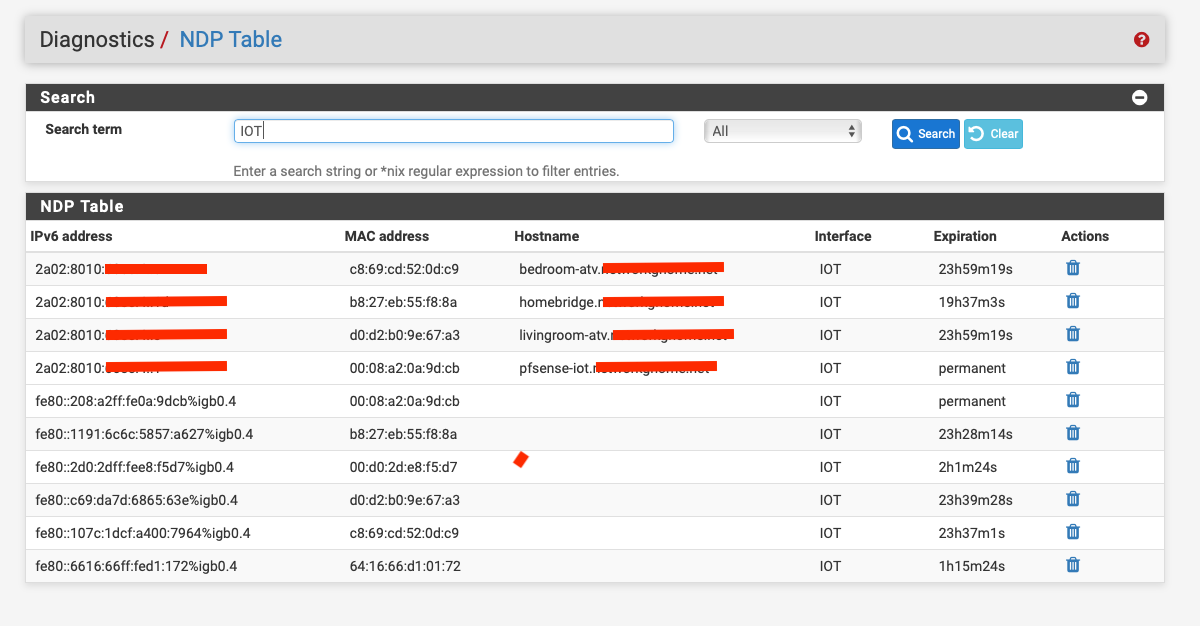
-
Take the complaint to Apple and let them fix it. They're the ones who caused the problem.
I'd suggest the issue lies elsewhere see my previous post.
-
Perhaps @dg6464's TV is defective. I have never heard of any device doing that on IPv4 or IPv6. According to his description, each of the NDP entries is for a different IP address, but same MAC. There should only be a few but certainly not hundreds.
Perhaps he could run Packet Capture, foltering on the TV's MAC address and ICMP6, to see what's happening.
-
Apple TV's are a known pain in the butt when they go to sleep... they wreak havoc on my Meraki switches by transitioning to 100Mbps from 1Gbps and show CRC errors like there is a bad cable (this is a known issue and will likely never be fixed by Apple).
No CRC errors on the LAN port it's connected to here either, sure you don't have a cable issue ?
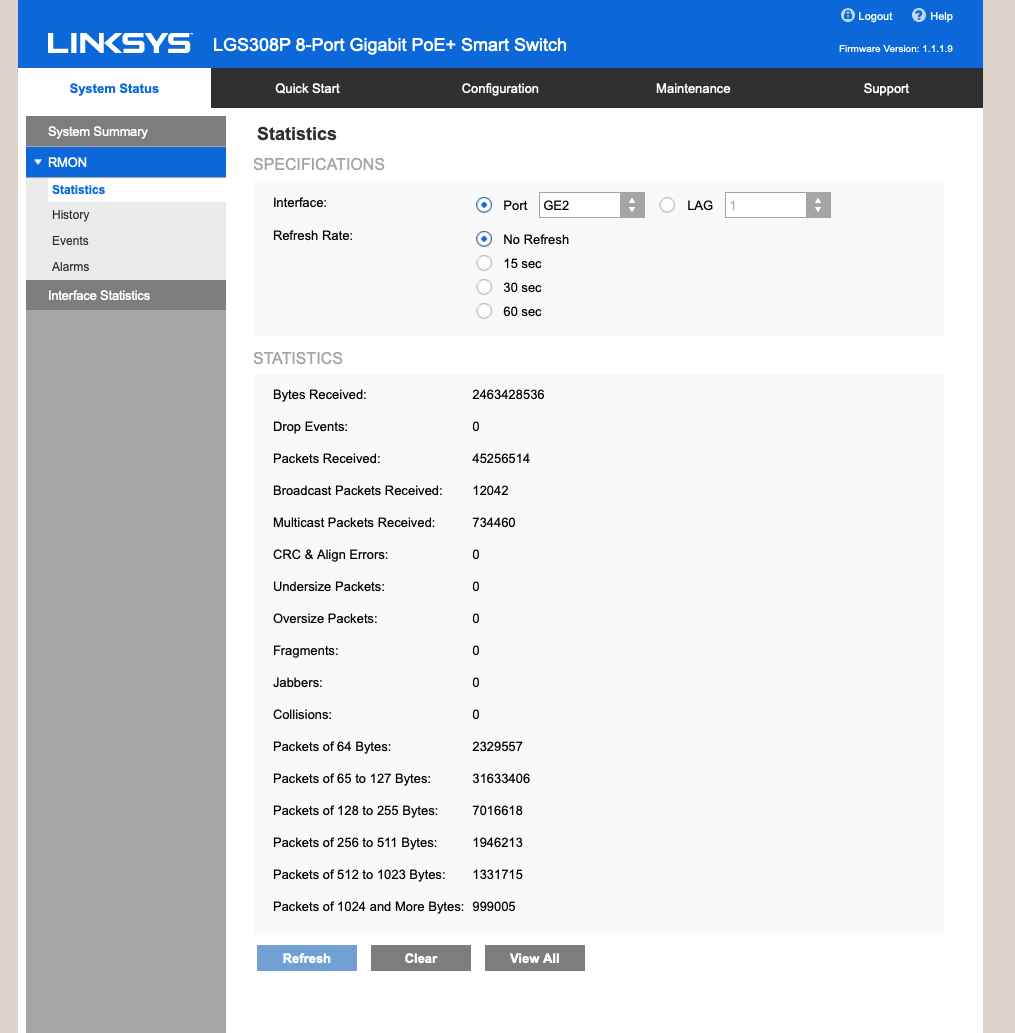
-
What speed does yours come up at? Autonegotiation should cause it do come up at the best possible.
Certainly a different cable should be tried. A flaky (pardon the tech jargon
 ) cable can cause the devices to think they can run at Gb, but the cable only permits 100 Mb.
) cable can cause the devices to think they can run at Gb, but the cable only permits 100 Mb. -
1 Gig, I think the previous versions ran 10/100 ports.
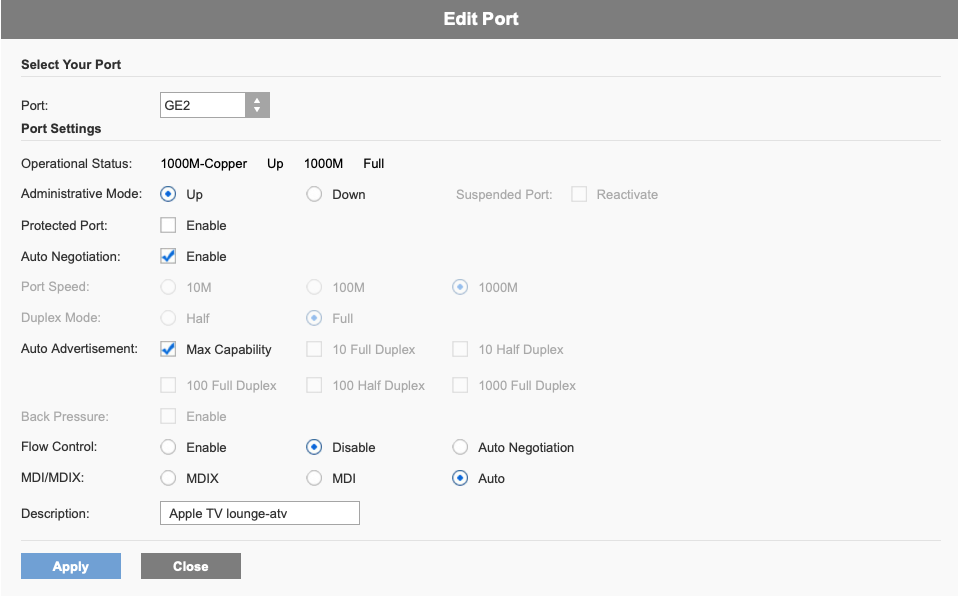
-
@NogBadTheBad this is an Apple TV issue only when it goes to sleep... this is an Apple TV 4K, but I believe it's the same for all Apple TV's.
On my Meraki switch, it re-negotiates to 10/100 down from it'a usual 1Gbps... then shows CRC errors for the time it's asleep.
Otherwise - I do a speedtest and get 1Gbps down.. have tested cables and such. I've got 3 Cat6 drops in that room to my basement switch... definitely not a cable.
I'll try and find the article where someone else stated this is a common Apple TV "sleep" problem and is the same with multiple vendors switches.
Best Regards,
dg6464
-
@JKnott so I just did a packet capture (albeit too big, it's like 107MB for just 30 seconds or so as I turned it on, booted up Netflix and Plex).
However... before doing so I cleared the NDP entires for the Apple TV.
They haven't come back.
So maybe while I was doing some IPv6 Testing or implementing IPv6 DNS on my pihole, it somehow generated a ton of these entries and they just stayed?
Not sure - but I will monitor moving forward.
-
@NogBadTheBad this might be a way of getting around it... if I just assign a static DHCPv6 for the MAC address. I'll give it a try if the NDP table issue keeps happening.
This will also be a simple way for me to keep the hostnames in check and make it easier to know what is what.
Did you find that the Apple TV's actually received a DHCPv6 address when you configured it?
Where did you configure those static DHCPv6 addresses? When I go to configure one it asks for a DUID and has no specific spot for the MAC Address?
Thanks!
Best Regards,
dg6464
-
What makes you think my ATV doesn’t go to sleep?
Have you got a spare lan port on your router to try and connect it to directly dos a test.
I originally let my ATV get a random IPv6 address then fixed it using the DUID address in the status - dhcpv6 leases page.
-
@NogBadTheBad I'm not saying it doesn't go to sleep... I'm saying your switch modem may not detect CRC align errors for some reason. It was more commercial gear that seemed to detect the issue.
I've tried multiple switching ports, multiple cables... and everything works perfectly when it's awake. Only when it goes to sleep does it have the issue.
As for the DHCPv6 lease... for some reason the DUID that it assigns won't allow me to assign a reservation:
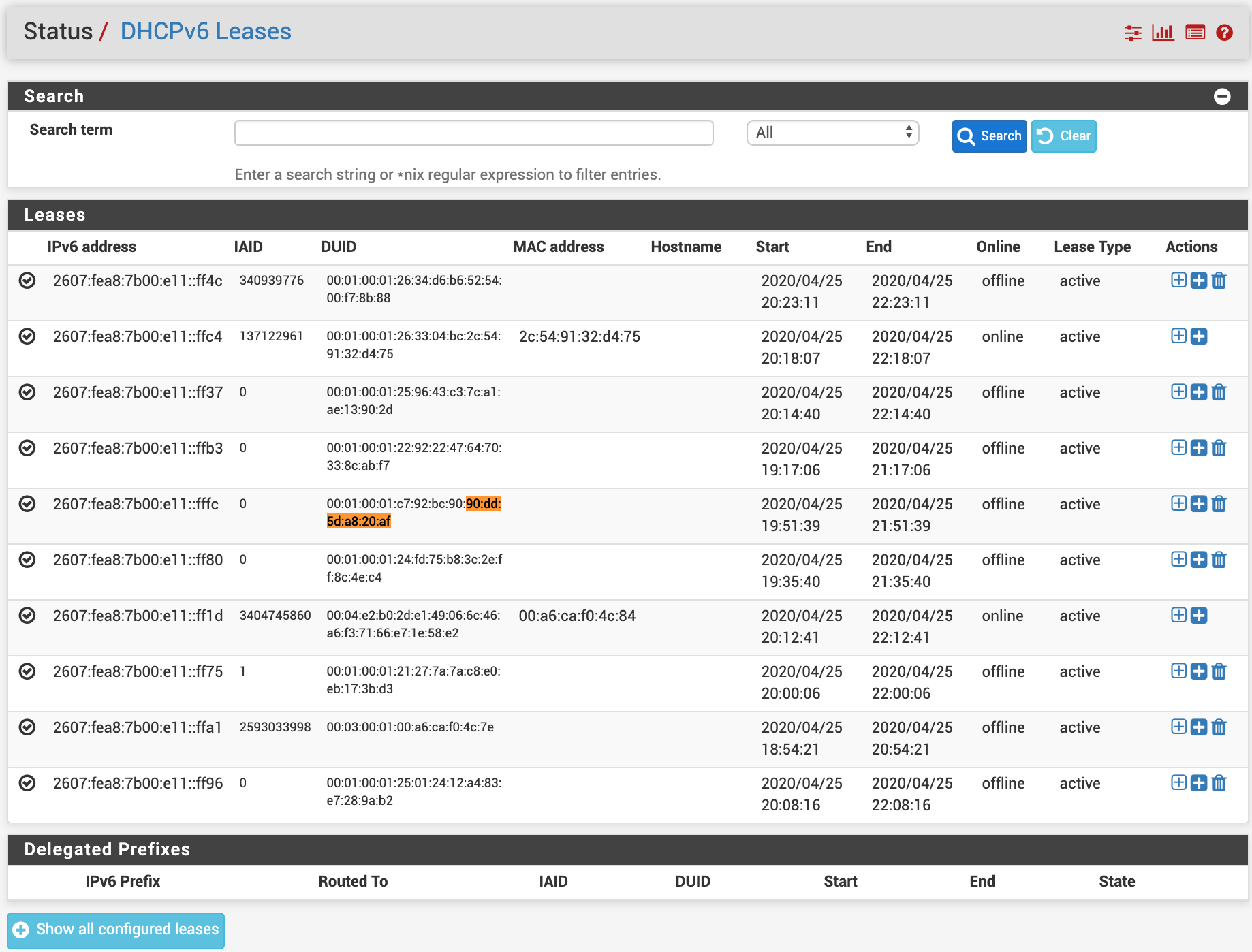
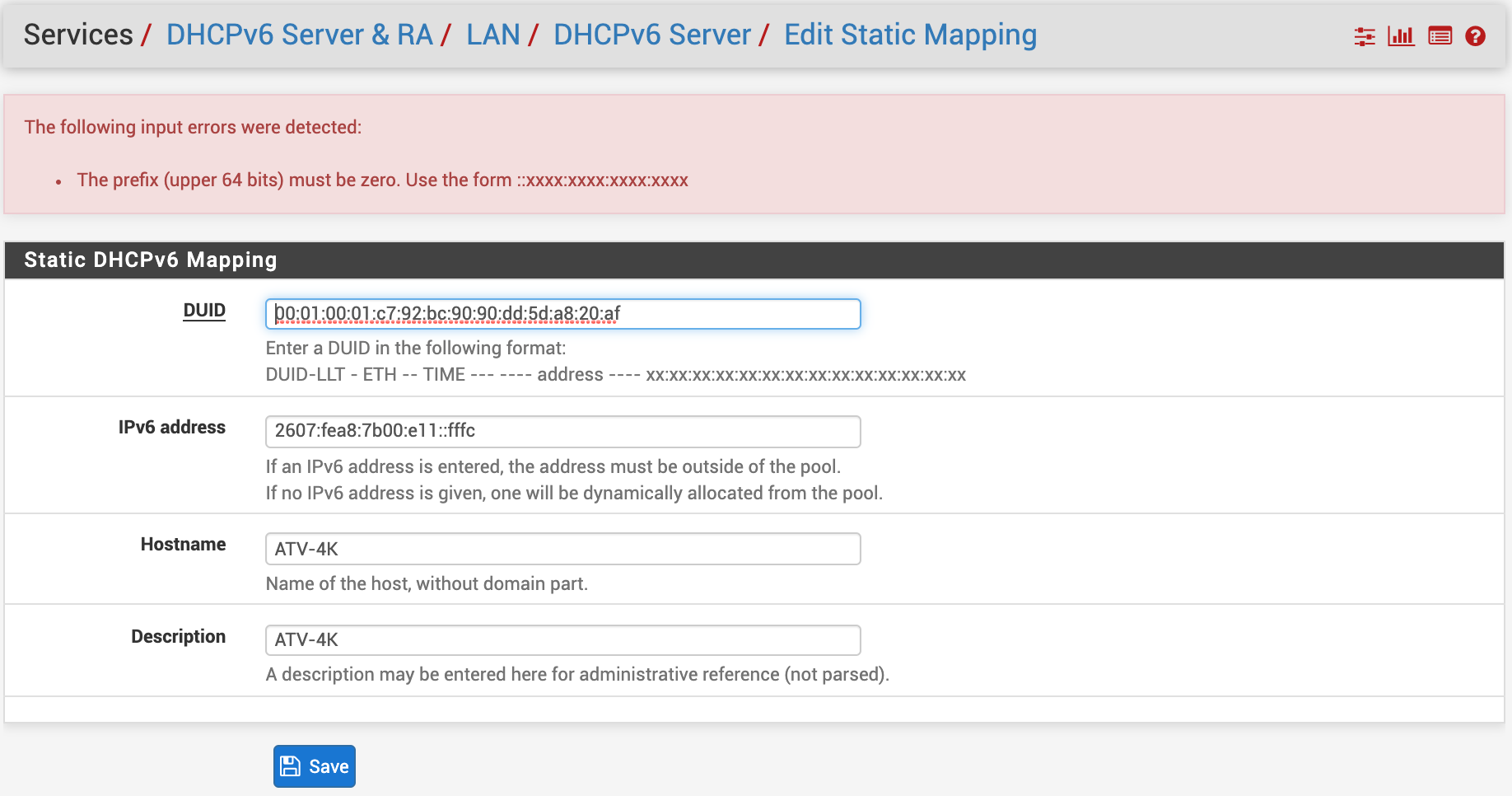
Either way... the NDP Table only has 1 entry now... the most I have seen yet is 4 entries for it now. Only time will tell.
Not that it helps at all, but the Meraki switch GUI with the CRC errors... you can see the "red" gaps.. that's where it goes to sleep:
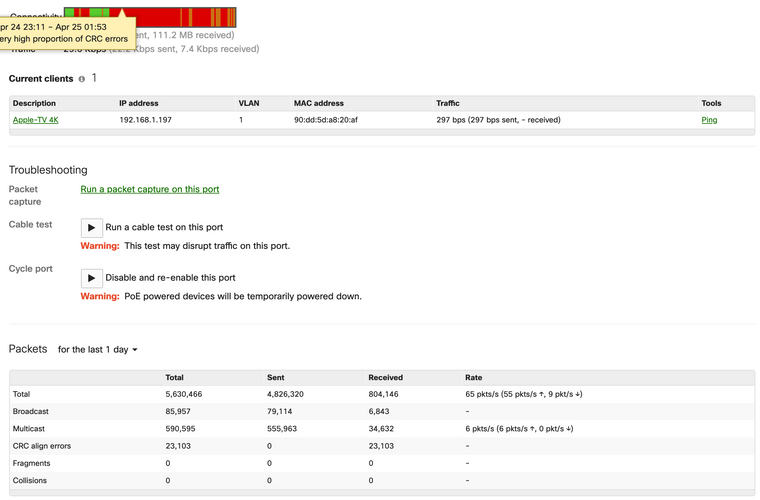
It's asleep right now, so it negotiates at 10/100:

Meraki thread about it:
[https://community.meraki.com/t5/Switching/AppleTV-4K-Ethernet-Madness/td-p/41254](link url)
-
@dg6464 said in IPv6 NDP Table - Hundreds of Entries for Single Mac Address (Apple TV):
if I just assign a static DHCPv6 for the MAC address.
I don't know that would do it. You'd still have the neighbour announcements. With SLAAC, you will have a link local address and at least 1 global address. With DHCPv6, you will have a link local address and 1 global address. I don't see much difference in that.
As for that huge packet capture, what happens if you wait for the dust to settle, before starting it? You should still see neighbour advertisements periodically.
-
@JKnott do you think it's worth running RA in "Managed" mode then, to force DHCPv6? Not sure if I am in a world of hurt for all of the IP's that have been assigned using SLAAC / RA already though (likely my pihole DNS servers IP, unRAID's IPv6 IP and such). Not sure if I turn off Assisted mode and move to Managed if the existing used IP's will show up as leases.
Honestly if most things are compatible with DHCPv6 now and don't require SLAAC / RA's and autoconfigure... i'd almost rather manage the DHCPv6 leases just like I manage the DHCP IPv4 leases today... one by one from the pool as a round-robin and configuring reservations when it makes sense.
I can try another packet capture as well if you'd like and just not boot up Netflix and such.
You think just a cycle from sleep to wake up to sleep again will do the trick?
I can tinker with the options if it makes sense... just thought I'd ask just in case I'm in for a world of hurt by changing from Assisted. Doesn't that basically disable auto-configure / SLAAC?
Existing Configuration for DHCPv6 and RA:
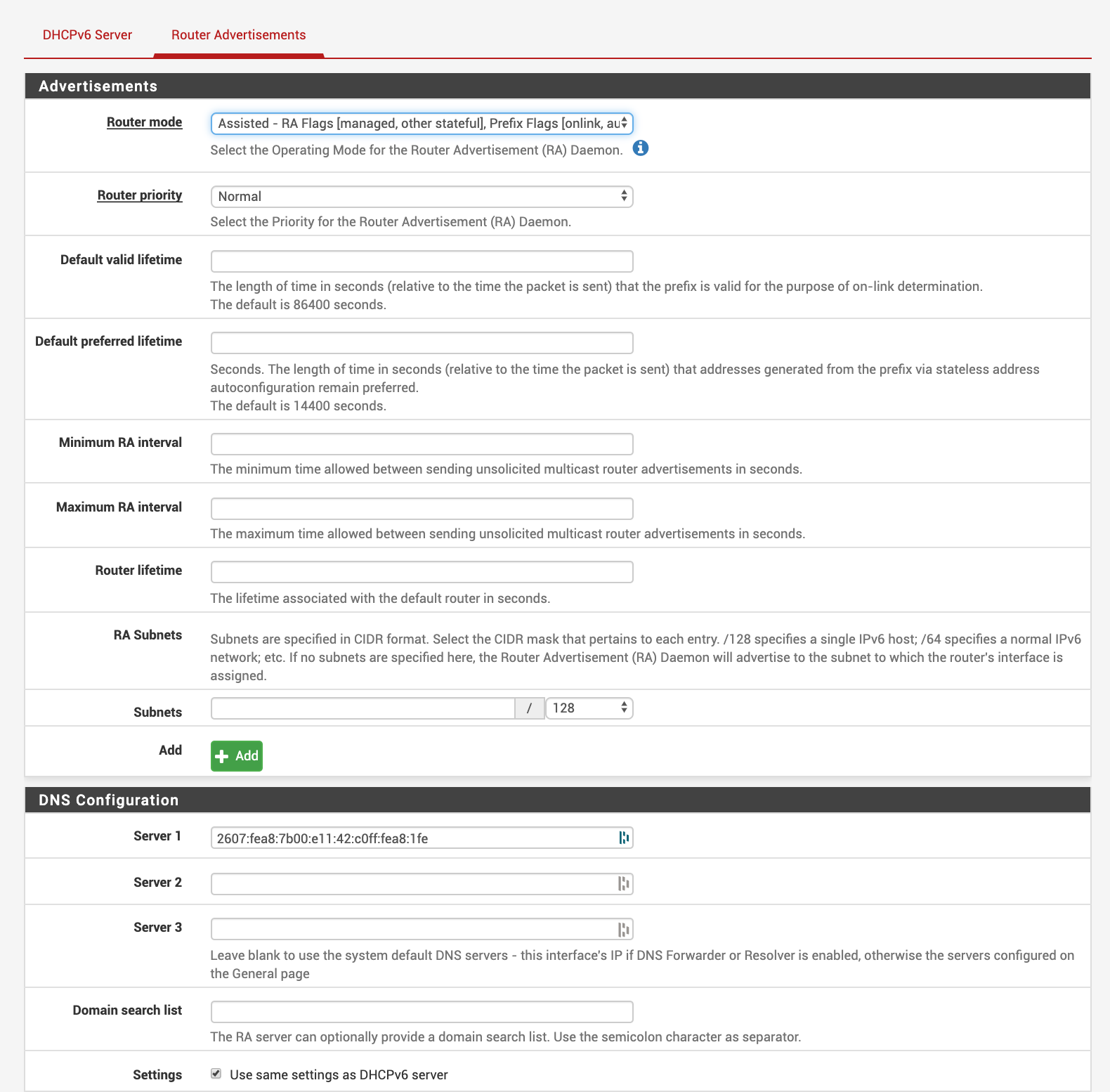
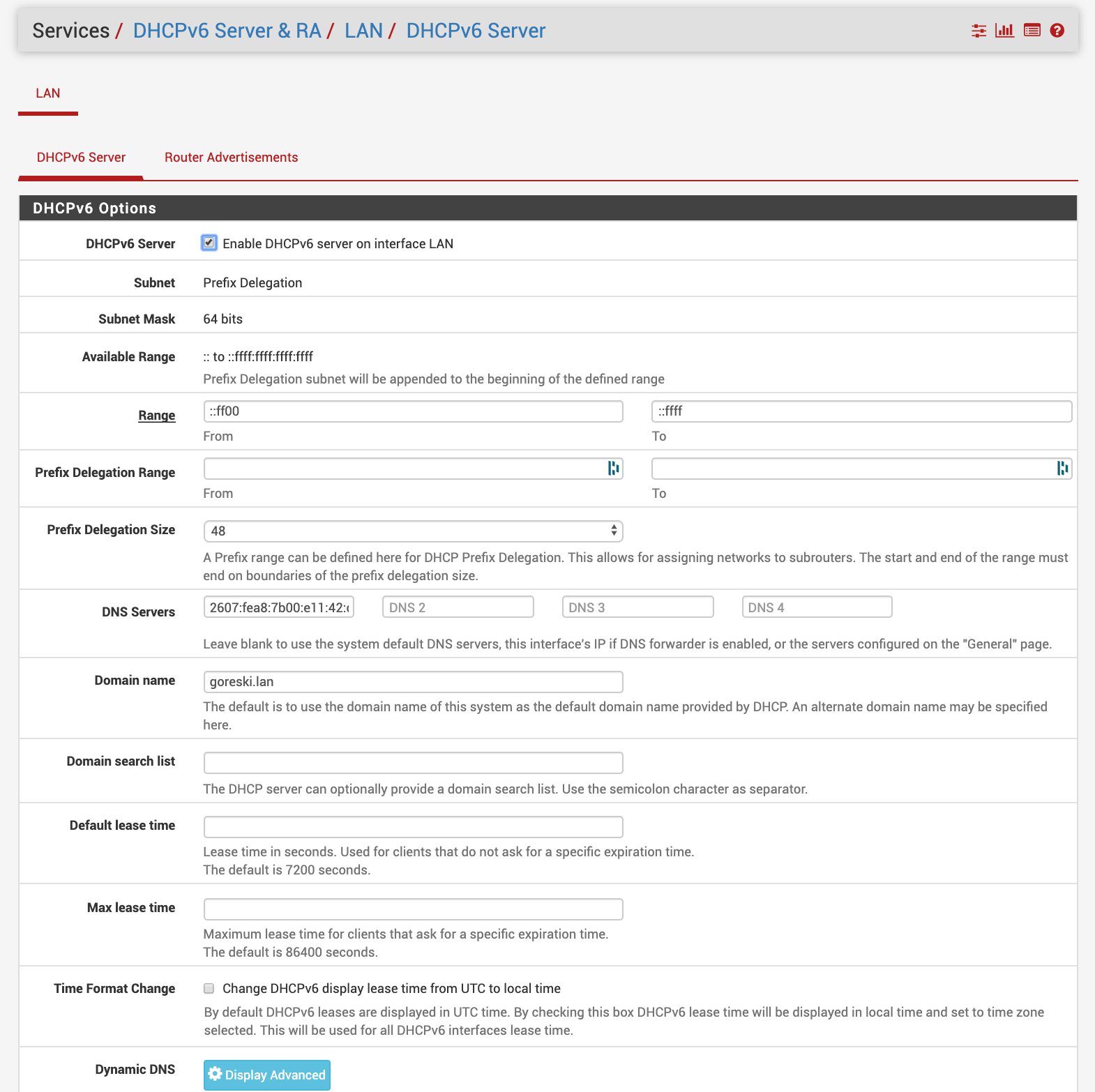
Thanks!
Best Regards,
dg6464